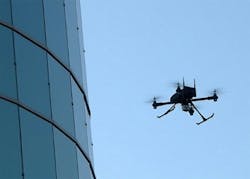UAV captures 3-D images of buildings
Unmanned aerial vehicles (UAVs) equipped with all manner of cameras are now being put to use in a variety of applications for monitoring vegetation, assessing power grid damage and helping soldiers to spot suspicious activity.
But now, engineers at the University of Granada (Granada, Spain) have found another use for them -- helping to produce 3-D models of historical buildings.
By capturing multiple geolocated images taken by onboard stereoscopic cameras from many different angles onboard the UAV, the researchers claim their system is able to produce a 3-D model of a historical building facade such as a cathedral at a lower cost than 3-D scanners, partly because it can do so without the need for scaffolding or cranes.
The University of Granada research groups that worked on the project were supported by engineers at university spin-offs Intelligenia Dynamics (Granada, Spain) and Virtum Graphics (Granada, Spain).
Other Spanish researchers, however, are more interested in using the UAVs to help agriculturalists. Headwall Photonics' (Fitchburg, MA, USA) Micro-Hyperspec imaging sensor, for example, is being successfully deployed onboard small commercial unmanned UAVs at the Instituto de Agricultura Sostenible (IAS) in Spain to assist agriculturalists monitor vegetation over wide areas.
Meanwhile, Australian researchers at the Queensland University of Technology (QUT; Brisbane, Australia) are developing a UAV to cut down the amount of herbicide sprayed on crops.
Aside from their agricultural uses, UAVs could soon be used to assess power grid damage following a storm or natural disaster. Researchers at New Mexico State University (NMSU; Las Cruces, NM, USA) and the Electric Power Research Institute (EPRI; Palo Alto, CA, USA) recently completed tests on a system that could do just that.
In the UK, researchers are more interested in developing a system that could help soldiers to spot hidden dangers during military operations. To do so, engineers from Middlesex University (London, UK) have created a Frisbee-sized UAV equipped with cameras that can quietly hover or even perch on objects as its cameras then zoom in on suspicious activity.
-- by Dave Wilson, Senior Editor, Vision Systems Design
